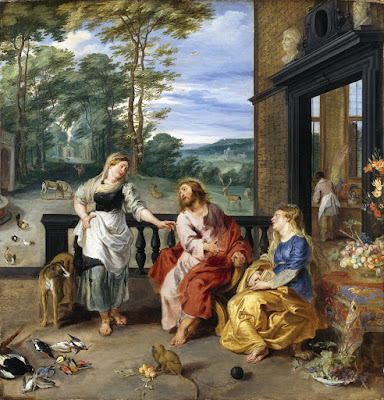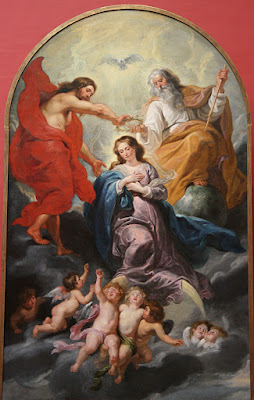 |
| Peter Paul Rubens St Michael Archangel vanquishing the Rebel Angels ca. 1618-20 oil on canvas (sketch for ceiling painting) Musées Royaux des Beaux-Arts, Brussels |
 |
| Peter Paul Rubens Triumph of the Eucharist (detail) before 1640 oil on canvas (cartoon for tapestry) Musées Royaux des Beaux-Arts, Brussels |
 |
| Peter Paul Rubens St Francis receiving the Christ Child from the Virgin ca. 1617 oil on canvas Palais des Beaux-Arts de Lille |
 |
| Peter Paul Rubens St Francis ca. 1620 oil on canvas Palais des Beaux-Arts de Lille |
 |
| Peter Paul Rubens St Bonaventure ca. 1620 oil on canvas Palais des Beaux-Arts de Lille |
 |
| Peter Paul Rubens and Jan Brueghel the Younger Christ in the House of Mary and Martha 1628 oil on panel National Gallery of Ireland, Dublin |
 |
| Peter Paul Rubens Assumption of the Virgin ca. 1611-12 oil on canvas Musées Royaux des Beaux-Arts, Brussels |
 |
| Peter Paul Rubens Assumption of the Virgin ca. 1611-12 oil on panel (sketch) Royal Collection, Great Britain |
 |
| Peter Paul Rubens and workshop Coronation of the Virgin ca. 1625 oil on canvas Musées Royaux des Beaux-Arts, Brussels |
 |
| Peter Paul Rubens Martyrdom of St Catherine ca. 1615 oil on panel Palais des Beaux-Arts de Lille |
 |
| Peter Paul Rubens Martyrdom of St Lebuinas ca. 1633-35 oil on panel (sketch) Museum Boijmans Van Beuningen, Rotterdam |
 |
| Peter Paul Rubens Christ and the Woman taken in Adultery 1614 oil on canvas Musées Royaux des Beaux-Arts, Brussels |
 |
| Peter Paul Rubens Christ's Charge to Peter ca. 1614 oil on canvas Gemäldegalerie, Berlin |
 |
| Peter Paul Rubens and Jan Brueghel the Elder Garden of Eden ca. 1615 oil on canvas Mauritshuis, The Hague |
 |
| Peter Paul Rubens Samson and Delilah 1609 oil on panel National Gallery, London |
"The Catholic Rubens: Saints and Martyrs by Willibald Sauerländer (translated from German by David Dollenmayer and published by Getty Research Institute, 2014) presents Rubens not as an artist reluctantly at work for ecclesiastical authorities, but as a painter and believer knowledgeably involved with the new doctrines of Catholic life after 1600. . . . Sauerländer thinks that not a few art historians have seen Rubens's work as diminished by the many religious figures he painted. He is, however, not the reluctant employee of Catholic interests. "Rubens drew his inspiration from a treasury of ecclesiastical traditions, but his festal, miraculous, yet also deeply human, altarpieces became in their turn a powerful source of reinforcement and renewal for the old faith."
– from a review of Sauerländer's book by Thomas F. O'Meara